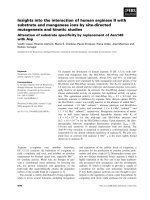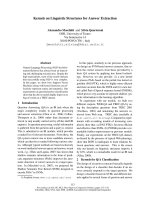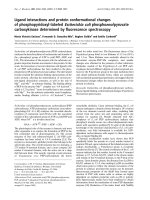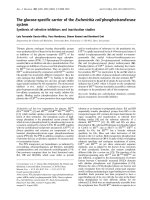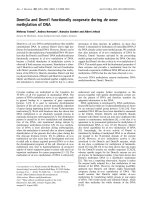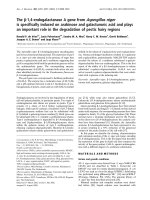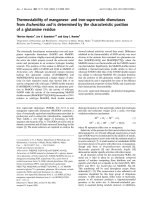Tài liệu Báo cáo Y học: Studies on the nonmevalonate pathway of terpene biosynthesis The role of 2C-methyl-D -erythritol 2,4-cyclodiphosphate in plants docx
Bạn đang xem bản rút gọn của tài liệu. Xem và tải ngay bản đầy đủ của tài liệu tại đây (464.01 KB, 9 trang )
Studies on the nonmevalonate pathway of terpene biosynthesis
The role of 2
C
-methyl-D-erythritol 2,4-cyclodiphosphate in plants
Monika Fellermeier
1
, Maja Raschke
1
, Silvia Sagner
1
, Juraithip Wungsintaweekul
2
, Christoph A. Schuhr
2
,
Stefan Hecht
2
, Klaus Kis
2
, Tanja Radykewicz
2
, Petra Adam
2
, Felix Rohdich
2
, Wolfgang Eisenreich
2
,
Adelbert Bacher
2
, Duilio Arigoni
3
and Meinhart H. Zenk
1
1
Biozentrum-Pharmazie, Universita
¨
t Halle, Halle/Saale, Germany;
2
Lehrstuhl fu
¨
r Organische Chemie und Biochemie, Technische
Universita
¨
tMu
¨
nchen, Garching, Germany;
3
Laboratorium fu
¨
r Organische Chemie, Eidgeno
¨
ssische Technische Hochschule Ho
¨
nggerberg,
Zu
¨
rich, Switzerland
2C-Methyl-D-erythritol 2,4-cyclodiphosphate was recently
shown to be formed from 2C-methyl-
D-erythritol 4-phos-
phate by the consecutive action of IspD, IspE, and IspF
proteins in the nonmevalonate pathway of terpenoid
biosynthesis. To complement previous work with radio-
labelled precursors, we have now demonstrated that
[U-
13
C
5
]2C-methyl-D-erythritol 4-phosphate affords
[U-
13
C
5
]2C-methyl-D-erythritol 2,4-cyclodiphosphate in
isolated chromoplasts of Capsicum annuum and Narcissus
pseudonarcissus. Moreover, chromoplasts are shown to
efficiently convert 2C-methyl-
D-erythritol 4-phosphate as
well as 2C-methyl-
D-erythritol 2,4-cyclodiphosphate into
the carotene precursor phytoene. The bulk of the kinetic data
collected in competition experiments with radiolabeled
substrates is consistent with the notion that the cyclodipho-
sphate is an obligatory intermediate in the nonmevalonate
pathway to terpenes. Studies with [2,2
0
-
13
C
2
]2C-methyl-
D-erythritol 2,4-cyclodiphosphate afforded phytoene
characterized by pairs of jointly transferred
13
C atoms in
the positions 17/1, 18/5, 19/9, and 20/13 and, at a lower
abundance, in positions 16/1, 4/5, 8/9, and 12/13. A detailed
scheme is presented for correlating the observed partial
scrambling of label with the known lack of fidelity of
the isopentenyl diphosphate/dimethylethyl diphosphate
isomerase.
Keywords: nonmevalonate pathway; terpene; chromoplasts;
2C-methyl-
D-erythritol 2; 4-cyclodiphosphate.
For a period of several decades, the mevalonate pathway
elucidated in animal cells and yeast by the studies of Bloch,
Cornforth and Lynen has been considered as the universal
source of isoprenoid precursors for the biosynthesis of
terpenoids (reviewed in [1–4]). In recent years, a second
pathway was discovered in certain eubacteria and plants by
the research groups of Rohmer and Arigoni (reviewed in [5–
7]). Specifically, the incorporation of
13
C-labeled acetate
and glucose in bacteria such as Rhodopseudomonas
palustris [8] and Escherichia coli [9], as well as in plants
[10] suggested a triose and pyruvate as precursors for the
formation of isoprenoids via the alternative pathway.
Arigoni and his coworkers found that 1-deoxy-
D-xylu-
lose, a known precursor of the vitamins thiamine [11] and
pyridoxol [12], could be incorporated into terpenoids by
E. coli [9] as well as by higher plants [7]. More specifically,
plants were shown to utilize the mevalonate pathway in the
cytoplasmic compartment and the nonmevalonate pathway
in the plastid compartment [7,10,13,14]. More recently, the
origin of a variety of plant terpenoids could be assigned to
this plastid-based nonmevalonate pathway (reviewed in [6]).
Recent studies by several research groups identified
1-deoxy-
D-xylulose 5-phosphate synthase as the first
enzyme of the alternative terpenoid pathway in certain
bacteria [15–17] and plants [18,19]. The enzyme product is
converted into the branched chain polyol, 2C-methyl-
D-erythritol 4-phosphate, by a reductoisomerase via a
skeletal rearrangement followed by an NADPH-dependent
reduction [20– 23].
We have shown that in E. coli 2C-methyl-
D-erythritol
4-phosphate can be converted into a cyclic diphosphate by the
consecutive action of 4-diphosphocytidyl-2C-methyl-
D-
erythritol synthase, 4-diphosphocytidyl-2C-methyl-
D-erythritol
kinase and 2C-methyl-
D-erythritol 2,4-cyclodiphosphate
synthase [24–26] (Fig. 1). In the meantime, some of these
results have been confirmed by other authors [27–29].
We have also shown that
14
C-labelled 2C-methyl-D-ery-
thritol 2,4-cyclodiphosphate is incorporated into the lipid
fraction of Capsicum annuum chromoplasts [26].
2C-methyl-
D-erythritol 2,4-cyclodiphosphate had been
isolated earlier as a stress metabolite from bacterial cultures
in high yield [30,31].
In this paper we describe the kinetics of 2C-methyl-
D-erythritol 2,4-cyclodiphosphate incorporations into
chromoplast preparations of C. annuum and Narcissus
pseudonarcissus, as well as the incorporation of [U-
13
C
5
]2-
C-methyl-
D-erythritol 2,4-cyclodiphosphate into phytoene
from chromoplasts of C. annuum.
EXPERIMENTAL PROCEDURES
Materials
[1-
3
H]2C-methyl-D-erythritol 4-phosphate was prepared
according to a method described by Kis et al. using sodium
Correspondence to W. Eisenreich, Lehrstuhl fu
¨
r Organische Chemie
und Biochemie, Technische Universita
¨
tMu
¨
nchen, Lichtenbergstr. 4,
D-85747 Garching, Germany. Fax: þ 49 89 289 13363,
Tel.: þ 49 89 289 13043, E-mail:
(Received 5 July 2001, revised 8 October 2001, accepted
9 October 2001)
Eur. J. Biochem. 268, 6302–6310 (2001) q FEBS 2001
Fig. 1. Biosynthesis of phytoene via the nonmevalonate pathway.
q FEBS 2001 Isoprenoid biosynthesis in plants (Eur. J. Biochem. 268) 6303
[
3
H]borohydride as reducing agent [32] [2,2
0
-
13
C
2
]-,
[2-
14
C]2C-methyl-D-erythritol 2,4-cyclodiphosphate, and
[U-
13
C
5
]2C-methyl-D-erythritol 4-phosphate were prepared
as described [33,34].
Isolation of chromoplasts from
C. annuum
Chromoplasts were isolated by a slight modification of the
method first described by Camara [35,36]. Pericarp of red
pepper (500 g) was homogenized at 4 8C in 600 mL of 50 m
M
Hepes, pH 8.0, containing 1 mM dithioerythritol, 1 mM
EDTA and 0.4 M sucrose (buffer A). The suspension was
filtered through four layers of nylon cloth (50 mm) and
centrifuged (10 min, 3290 g, GSA rotor) to obtain a pellet of
crude chromoplasts which was homogenized in 400 mL of
buffer A. The suspension was centrifuged (10 min, 3290 g,
GSA rotor). The pellet was homogenized and resuspended
in 3 mL of 50 m
M Hepes, pH 7.6, containing 1 mM 1,4-
dithioerythritol. The suspension was filtered through one layer
of nylon cloth (50 mm).
Preparation of a chromoplast extract
A suspension of washed C. annuum chromoplasts (5 mL;
protein concentration, 10 –15 mg·mL
21
) was diluted with
50 m
M Hepes, pH 7.6, containing 1 mM dithioerythritol to a
final volume of 40 mL. The mixture was kept for 10 min at
4 8C and was then centrifuged (60 min, 110 560 g,Ti50
rotor). The supernatant was applied to aSephadex G-25column
(type PD-10, Amersham Pharmacia Biotech) which had been
equilibrated with 50 m
M Hepes, pH 7.6, containing 1 mM
dithioerythritol. The column was developed with the same
buffer. Fractions were combined and concentrated using a
Centriprep-10 concentrator (Amicon). The final protein
concentration was about 1– 2 mg·mL
21
.
Isolation of chromoplasts from
N. pseudonarcissus
The isolation followed a procedure described by Kleinig &
Beyer [37]. Inner coronae of N. pseudonarcissus (80 g)
were homogenized in 250 mL of 67 m
M Tris/HCl, pH 7.5,
containing 5 m
M MgCl
2
,1mM dithioerythritol, 1 mM
EDTA, 0.2% (w/v) polyvinylpyrrolidone K90, and 0.74 M
sucrose. The suspension was filtered (three layers of nylon
cloth, 50 mm) and centrifuged (5 min, 1990 g, GSA rotor).
The supernatant was centrifuged (20 min, 25 400 g, GSA
rotor) affording a pellet of crude chromoplasts which was
resuspended in 2 mL of 67 m
M Tris/HCl, pH 7.5, contain-
ing 5 m
M MgCl
2
,1mM dithioerythritol and 50% (w/v)
sucrose. The suspension was filtered through one layer of
nylon cloth (50 mm). Aliquots of 2 mL were transferred to
centrifuge tubes. Equal volumes of 40, 30 and 15% (w/v)
sucrose in 67 m
M Tris/HCl, pH 7.5, containing 5 mM
MgCl
2
and 1 mM dithioerythritol were placed on top of
the chromoplast suspension. Subsequent to centrifugation
(60 min, 64 000 g, SW28 rotor), the fraction of intact
chromoplasts at the 40/30% interphase was collected and
diluted with 67 m
M Tris/HCl containing 5 mM MgCl
2
and
1m
M dithioerythritol to a final sucrose concentration of
15% (w/v). The suspension was centrifuged (20 min,
25 130 g, SS34 rotor) and the pellet was suspended in
2mLof67m
M Tris/HCl, pH 7.5, containing 5 mM MgCl
2
and 1 mM dithioerythritol.
Incorporation experiments with isotope-labeled
substrates
Reaction mixtures contained 100 m
M Hepes, pH 7.6, 2 mM
MnCl
2
,10mM MgCl
2
,5mM NaF, 2 mM NADP
þ
,1mM
NADPH, 6 mM ATP, 20 mM FAD and chromoplasts or
chromoplast extract. Isotope-labeled 2C-methyl-
D-erythritol
4-phosphate and/or 2C-methyl-
D-erythritol 2,4-cyclodiphos-
phate were added as indicated in Table 1. The mixtures were
incubated at 30 8C. The reaction was terminated by ethyl
acetate extraction. The lipid extract was dried over sodium
sulfate. In experiments with radiolabeled substrates the
residue was analyzed by scintillation counting and/or
HPLC. The aqueous phase was analyzed by reversed phase
ion pair HPLC monitored by scintillation counting.
HPLC analysis of phosphorylated metabolites
Reversed phase ion pair HPLC separations were performed
with a Luna C8 column (Phenomenex, 5 mm,
4 £ 250 mm). The column was developed with a linear
gradient of 0–42% methanol in 10 m
M tetrabutylammo-
nium sulfate, pH 6.0 (total volume, 60 mL; flow rate,
0.75 mL min
21
). The retention volumes of 2C-methyl-
D-erythritol 4-phosphate and 2C-methyl-D-erythritol
2,4-cyclodiphosphate were 10.0 and 29.0 mL, respectively.
Table 1. Competition experiments with [1-
3
H]2C-methyl-D-erythritol 4-phosphate (MEP) and [2-
14
C]2C-methyl-D-erythritol 2,4-cyclodi-
phosphate (cMEPP) in a chromoplast system from C. annuum. In each experiment, the sample volume was 150 mL. Conc., concentration; Sp.
radioact., specific radioactivity.
Proffered precursors
Radioactivity incorporation into
[2-
14
C]cMEPP [1-
3
H]MEP
[1-
3
H]cMEPP
the lipid-soluble material
Experiment
Conc.
(m
M)
Sp. radioact.
(mCi·mmol
21
)
Conc.
(mM)
Sp. radioact.
(mCi·mmol
21
)
14
C:
3
H
(%
a
)
produced
(nmol)
14
C
(nmol)
3
H
(nmol)
14
C:
3
H
(%
a
)
A 0.040 20 0.01 360 80 : 20 0.1 2.2 0.3 88 : 12
B 0.040 20 0.08 45 33 : 67 0.9 2.0 2.3 46 : 54
C 0.040 20 0.68 4.40 5.5 : 94.5 6.8 1.8 8.5 17 : 83
D 0.040 20 6.68 0.41 0.6 : 99.4 13.0 0.4 8.0 4.7 : 95.3
a
Relative molar contribution of
14
C vs.
3
H pool.
6304 M. Fellermeier et al. (Eur. J. Biochem. 268) q FEBS 2001
Isolation of 2C-methyl-D-erythritol 2,4-cyclodiphosphate
The reaction mixture was centrifuged and the supernatant
was applied to a CHROMABONDw SB column (500 mg,
Macherey & Nagel). The column was washed with water
and developed with 0.1
M ammonium bicarbonate. The
effluent was passed through a column of DOWEX AG
50 W-X8 (100 –200 mesh, H
þ
-form) and was then
lyophilized. The residue was dissolved in water and applied
to a Nucleosil 10SB HPLC-column which was developed
with 100 m
M ammonium formate in 40% (v/v) methanol at
a flow rate of 1 mL·min
21
. The effluent was monitored by
scintillation counting. The retention time of 2C-methyl-
D-erythritol 2,4-cyclodiphosphate was 26 min Fractions
were combined and lyophilized.
Isolation of phytoene
Fresh red peppers (107 g) were homogenized and
lyophilized. The dry powder was extracted with ethyl
acetate (2.5 L). The solution was brought to dryness under
reduced pressure. The residue was dissolved in 10 mL of a
hexane/ethylacetate mixture (1 : 1, v/v). The solution was
placed on a column of silica gel 60 (5 £ 40 cm) which was
developed with a mixture of a hexane/ethylacetate (1 : 1; v/v).
The red-colored fraction (400 – 480 mL) was collected and
concentrated under reduced pressure. The residue was
dissolved in 100 mL of chloroform.
Purification of phytoene
Aliquots (10 mL) of crude phytoene solution in chloroform
were applied to a Hypersil RP18 HPLC column (5 mm,
4.5 £ 250 mm, ThermoQuest Germna GmbH, Egelsbach,
Germany) that was developed with a mixture of isopropanol/
acetonitrile/water (50 : 45 : 5, v/v). The effluent was
monitored photometrically (280 nm). The retention
volumes of b-carotene, phytoene, and xanthophylls were
12, 14, and 20 mL, respectively.
NMR spectroscopy
NMR spectra were recorded with a DRX 500 spectrometer
from Bruker Instruments (Karlsruhe, Germany) equipped
with four channels and a pulsed gradient unit. Two
dimensional homocorrelation and heterocorrelation experi-
ments were performed with
XWINNMR software from Bruker
Instruments. Phytoene was measured in CDCl
3
,and
2C-methyl-
D-erythritol 2,4-cyclodiphosphate was measured
in D
2
O.
RESULTS
Isolated chromoplasts of C. annuum were incubated with
mixtures of [1-
3
H]2C-methyl-D-erythritol 4-phosphate and
[2-
14
C]2C-methyl-D-erythritol 2,4-cyclodiphosphate
(Table 1) and were then extracted with ethyl acetate. The
aqueous phase was analyzed by HPLC in order to monitor
the conversion of [1-
3
H]2C-methyl-D-erythritol 4-phosphate
into the corresponding 2,4-cyclodiphosphate. The organic
phase was analyzed for
3
H and
14
C in order to monitor the
transformation of the proffered radioactive compounds into
lipid-soluble material.
The data summarized in Table 1 indicate that
[1-
3
H]2C-methyl-D-erythritol 4-phosphate was diverted effici-
ently to the 2C-methyl-
D-erythritol 2,4-cyclodiphosphate
Fig. 3.
13
C NMR signals of 2C-methyl-D-erythritol 2,4-cyclodiphosphate obtained by incubation of [U-
13
C
5
]2C-methyl-D-erythritol
4-phosphate with a chromoplast extract of C. annuum.
13
C and
31
P coupling patterns are indicated.
Fig. 2. Diversion of radioactivity from [2-
14
C]2C-methyl-D-ery-
thritol 2,4-cyclodiphosphate into lipid-soluble material of chromo-
plasts from Narcissus pseudonarcissus. (A) 2C-methyl-
D-erythritol
2,4-cyclodiphosphate; (B) lipid-soluble fraction.
q FEBS 2001 Isoprenoid biosynthesis in plants (Eur. J. Biochem. 268) 6305
pool. The amount of newly formed [1-
3
H]2C-methyl-
D-erythritol 2,4-cyclodiphosphate increased with the con-
centration of the proffered [1-
3
H]2C-methyl-D-erythritol
4-phosphate; the transformation showed saturation
characteristics.
[1-
3
H]2C-methyl-D-erythritol 4-phosphate as well as
[2-
14
C]2C-methyl-D-erythritol 2,4-cyclodiphosphate were
efficiently converted into lipid-soluble material. The amount
of [1-
3
H]2C-methyl-D-erythritol 4-phosphate converted into
lipid-soluble material increased with the concentration of
the profferred substrate; saturation was reached at a
substrate concentration of less than 1 m
M.
The transformation of
14
C-labeled cyclic diphosphate into
lipid-soluble compounds had its maximum efficacy
(approximately 35%) at low concentrations of proffered
[1-
3
H]2C-methyl-D-erythritol 4-phosphate. At high concen-
trations of this compound, the incorporation of
14
C-label
from the cyclic diphosphate into the lipid-soluble fraction
was significantly diminished.
In a similar experiment, we studied the formation of lipid-
soluble material from [2-
14
C]2C-methyl-D-erythritol
Fig. 4.
13
C NMR signals of phytoene obtained from [2,2
0
-
13
C
2
]2-
C-methyl-
D-erythritol 2,4-cyclodiphosphate by incubation with
chromoplasts of C. annuum.
13
C coupling patterns are indicated.
Table 2.
13
C NMR assignments for phytoene.
Position
13
C-Chemical shift
(d, p.p.m.)
a
J
CC
b
(Hz) INADEQUATE
b
1, 1
0
131.23 42.3 17, 17
0
2, 2
0
123.97
3, 3
0
26.77
4, 4
0
39.72 42.5, 3.5
5, 5
0
d
134.93 42.5 18, 18
0
6, 6
0
124.22
7, 7
0
26.74
8, 8
0
39.72 42.5, 3.5
9, 9
0
d
135.33 42.2 19, 19
0
10, 10
0
124.41
11, 11
0
26.68
12, 12
0
40.49 40.7
13, 13
0
139.51 42.0 20, 20
0
14, 14
0
120.22
15, 15
0
123.35
16, 16
0
25.69 43.3
17, 17
0
17.68 42.2
18, 18
0
16.00 42.2
19, 19
0
16.04 42.2
20, 20
0
16.52 42.0
a
Referenced to external TMS;
b
from the experiment with [2,2
0
-
13
C
2
]2-
C-methyl-
D-erythritol 2,4-cyclodiphosphate;
c–e
assignments may be
interchanged.
Table 3.
13
C-Labeling pattern of phytoene obtained from chromo-
plasts of C. annuum incubated with [2,2
0
-
13
C
2
]2C-methyl-
D-erythritol 2,4-cyclodiphosphate. ND, not determined, due to signal
overlapping.
Position
13
C
a
(%)
13
C–
13
C
b
(%)
1, 1
0
ND 86
2, 2
0
1.1
3, 3
0
c
1.1
4, 4
0
ND 31
5, 5
0
d
ND 85
6, 6
0
1.3
7, 7
0
c
1.3
8, 8
0
ND 31
9, 9
0
d
ND 85
10, 10
0
1.1
11, 11
0
c
1.2
12, 12
0
1.5 25
13, 13
0
10.5 86
14, 14
0
1.1
15, 15
0
1.0
16, 16
0
1.8 31
17, 17
0
9.0 82
18, 18
0
c
9.8 82
19, 19
0
c
8.5 83
20, 20
0
8.9 86
a
Calculated as the relative
13
C abundance by comparison of
13
C NMR signal
intensities of the labeled sample with
13
C NMR signal intensities of an
unlabeled phytoene sample.
b
calculated as the fraction of the
13
C-coupled
satellites in the global
13
C NMR intensity of a given atom. c–e assignments
may be interchanged.
6306 M. Fellermeier et al. (Eur. J. Biochem. 268) q FEBS 2001
2,4-cyclodiphosphate using isolated chromoplasts from
N. pseudonarcissus (Fig. 2). The incorporation of radio-
actvity into lipid-soluble material was again checked by
solvent extraction of reaction mixtures and the consumption
of 2C-methyl-
D-erythritol 2,4-cyclodiphosphate was
monitored by HPLC analysis of the aqueous phase using a
scintillation detector. As shown in Fig. 2, the radioactive
substrate was virtually completely depleted and up to 94%
of the proffered radioactivity was transformed into lipid-
soluble material.
Next, experiments with precursors labeled with stable
isotopes were initiated. An extract prepared from isolated
chromoplasts of C. annuum was depleted of low molecular
mass compounds by gel filtration and was then incubated
with [U-
13
C
5
]2C-methyl-D-erythritol 4-phosphate in admix-
ture of a small amount of [2-
14
C]2C-methyl-D-erythritol
4-phosphate at 30 8C for 15 h as described under
Experimental procedures. A radioactive product was then
isolated from the reaction mixture and was analyzed by
13
C
NMR spectroscopy (Fig. 3).
All
13
C NMR signals of the isolated compound were
multiplets due to
13
C
13
C coupling. Based on chemical shift
values and coupling constants, the compound was identified
as 2C-methyl-
D-erythritol 2,4-cyclodiphosphate (see [26]
for NMR data of the authentic compound). The absence of
singlet signals for the carbon atoms 1, 2, 2-Me, 3 and 4 in the
spectrum of the isolated material demonstrates that the
proffered material had not been diluted by significant
amounts of endogenous material with natural
13
C abun-
dance. It follows that the chromoplast extract used did not
contain significant amounts of endogenous, unlabeled
2C-methyl-
D-erythritol 2,4-cyclodiphosphate.
Isolated chromoplasts from C. annuum were sub-
sequently incubated with 0.7 m
M [2,2
0
-
13
C
2
]2C-methyl-
D-erythritol 2,4-cyclodiphosphate at 30 8C for 12 h. The
suspension was extracted with ethyl acetate, and phytoene
(Fig. 1, compound 10) was isolated from the resulting
mixture of lipophilic compounds.
13
C NMR signals of the
isolated compound are shown in Fig. 4.
Signal assignments taken from [38] are supported by 1-
and 2- dimensional analysis of the
13
C-labeled phytoene
sample (Table 2). Eight of the 20
13
C signals of the labeled
phytoene appeared as singlets, eight signals showed high-
intensity satellites caused by
13
C–
13
C coupling, and four
signals were characterized by
13
C–
13
C coupling satellites of
lower intensity (Table 3). The
13
C connectivity was further
analyzed by a two-dimensional INADEQUATE experiment
showing four pairs of
13
C atoms (Fig. 5).
The terminal moiety of phytoene is biosynthetically
derived from dimethylalkyl diphosphate. Both methyl groups
(i.e. C-16 and C-17) of this moiety showed
13
C–
13
C coupling
satellites, albeit of different intensities (Table 3). The labeling
pattern of the reconstructed DMAPP unit is summarized in
Fig. 6 and the evaluation of the signal intensities indicated a
ratio of 10 : 1 for the two isotopomers a and b. The
13
C
NMR signals of the methyl groups C-18, C-19, and C-20 of
phytoene (biosynthetically equivalent to C-5 of IPP) showed
13
C-coupled satellites of high intensity (Table 3). From the
signal intensities the molar fraction of the IPP isotopomer c
can be calculated (Fig. 6).
The signals of C-12 and the coincident signals of carbon
atoms 4 and 8 showed one bond
13
C–
13
C coupling satellites
of lower intensities that were substantially broadened by
comparison with the central signal (Fig. 4). When processed
for maximum resolution, these satellites appeared as
pseudotriplets that could be due to long range coupling
involving vicinal isoprenoid moieties. Due to the line
broadening, the precision of signal integration is substan-
tially reduced. However, within the experimental limits, it
appears that the abundance of IPP isotopomer d is similar to
that of DMAPP isotopomer b (Fig. 6).
DISCUSSION
The conversion of 2C-methyl-D-erythritol 4-phosphate into
the corresponding 2,4-cyclodiphosphate by the consecutive
action of three recombinant E. coli enzymes (specified by
the ispD, ispE and ispF genes) has been described [24–29].
Orthologs of ispD and ispE from Arabidopsis thaliana and
tomato, respectively, have been expressed in recombinant
E. coli cells [39,40].
This paper shows that isolated chromoplasts from
C. annuum and N. pseudonarcissus catalyze the con-
version of 2C-methyl-
D-erythritol 4-phosphate into the
2,4-cyclodiphosphate in a process that displays saturation
kinetics and that the product of this reaction is further
processed efficiently into phytoene.
The results of the competition experiments summarized in
Table 1 demonstrate that the incorporation of radioactivity
from [1-
14
C]2C-methyl-D-erythritol 2,4-cyclodiphosphate
Fig. 5. Two-dimensional INADEQUATE spectrum of phytoene
obtained from [2,2
0
-
13
C
2
]2C-methyl-D-erythritol 2,4-cyclodipho-
sphate by incubation with chromoplasts of C. annuum.
Fig. 6. Reconstruction of the labeling pattern of IPP (isotopomers a
and b) and DMAPP (isotopomers c and d) from the labeling pattern
of the phytoene sample obtained in the experiment with
[2,2
0
-
13
C
2
]2C-methyl-D-erythritol 2,4-cyclodiphosphate. Bold lines
denote bonds linking adjacent
13
C atoms, numbers indicate the
percentage molar fraction of the isotopomers.
q FEBS 2001 Isoprenoid biosynthesis in plants (Eur. J. Biochem. 268) 6307
into phytoene (the main labeled component of the lipid-
soluble fraction) is systematically diminished by the
addition of increasing amounts of [1-
3
H]2C-methyl-D-ery-
thritol 4-phosphate. Moreover, the data show that even at
saturating concentrations of the tritiated compound, the
relative transfer of
14
C-label from the cyclodiphosphate pool
is always in excess of the value calculated from the original
molar concentration of the two precursors. This requires that
within the nonmevalonate pathway the cyclodiphosphate is
nearer than the 4-phosphate to IPP and DMAPP, the two C5
building blocks from which phytoene is assembled. Thus, on
all the available accounts the cyclodiphosphate behaves as
expected for an obligatory intermediate.
NMR spectroscopic analysis of the phytoene specimen
obtained from [2,2
0
-
13
C
2
]2C-methyl-D-erythritol 2,4-cyclo-
diphosphate reveals a partial scrambling of label between
(Z)- and (E)-methyl groups of DMAPP derived units and for
the corresponding IPP-derived internal units. A similar
partial scrambling of label between the (Z)- and (E)-methyls
of the starter DMAPP unit matched by a corresponding
scrambling within nonstarter C
5
-units derived from IPP in
the elongation process has been observed in the mevalonate
independent biosynthesis of carotenoids in cell cultures of
Catharanthus roseus [13] as well as for the DMAPP-derived
C
5
-unit of mevalonoid origin present in several clavine
alkaloids [41–43]; but for a possible exception [44], a
corresponding scrambling within the nonstarter C
5
units of
mevalonoid terpenes seems to have gone undetected,
probably because of the inadequacy of the analytical tools
employed in earlier work using a
14
C label. In all the cases
in which such a scrambling was observed it was usually
ascribed to a lack of fidelity of the isomerase that inter-
converts IPP and DMAPP. Participation of the isomerase is
of crucial importance in the mevalonate pathway, in which
formation of IPP and DMAPP take place in sequential steps;
in contrast, the available evidence indicates that within the
new pathway IPP and DMAPP are formed in independent
steps from a common and yet unidentified intermediate
[45–50], but a subsequent partial equilibration of the pre-
formed units can nevertheless occur in organisms equipped
with the isomerase, as is the case in higher plants in which
the two metabolic pathways are known to coexist.
The isomerization of IPP to DMAPP is an antarafacial
process in which a proton is added to the re-re face of the
double bond with subsequent or concomitant stereospecific
removal of the H
B
hydrogen at C-2 (Fig. 7) from the
opposite face of the molecule [51]; in the specific case of a
recombinant yeast enzyme, the catalytic groups have been
identified as Cys139, respectively, Glu207 [52]. In
refinement and extension of previous observations by
other authors [53], the Poulter group has carried out a
thorough investigation on the lack of fidelity of this
isomerase by analyzing the proton exchange that occurs
when IPP is incubated with the enzyme in D
2
O [54]; a rapid
exchange was detected for the C-4 hydrogens and one of C-2
hydrogens of IPP as well as for the (E)-methyl group of
DMAPP, followed by a slower exchange (2% of the
isomerization rate) of the methyl group of IPP and the
(Z)-methyl group of DMAPP, and an even slower exchange
(0.5% of the isomerization rate) of the olefinic hydrogen of
DMAPP corresponding to the H
A
-hydrogen at C-2 of IPP.
It is tempting to correlate this lack of regiochemical and
stereochemical fidelity of the enzyme with the bidentate
nature of the Glu207 carboxylate group positioned in the ES
complex of the reaction as indicated in Fig. 7; in this
geometric arrangement one of the oxygens is competent for
efficient removal of the H
B
hydrogen from C-2 of the
Fig. 7. Model representation for the positioning of the substrate in
the active site of IPP isomerase; (a) and (b) represent alternative
paths for proton abstraction from the substrate by the ambident
carboxylate group of Glu207.
Fig. 8. A detailed mechanistic scheme accounting for the known lack of fidelity of IPP isomerase. The resulting isotopic scrambling can be
visualized by following the fate of the C atom labeled with a black dot in the starting material represented in the squares. The alternative reaction paths
(a) and (b) correspond to the ones illustrated in Fig. 7. Sets A and B illustrate two different binding modes for the substrate.
6308 M. Fellermeier et al. (Eur. J. Biochem. 268) q FEBS 2001
substrate (path a), while the second oxygen is close enough to
the methyl group to catalyze, as an alternative, the occasional
removal of one of its hydrogens (path b). The outcome of the
two competing deprotonation paths is illustrated in Fig. 8 for
the predominant ES complex A of a sample of IPP carrying a
13
C label in its methyl group; a similar scheme involving a
less stable ES complex B is necessary to account for the
observed very slow exchange of the H
A
-hydrogen of IPP. In
both cases, scrambling of the label takes place within the IPP
pool and the error is then transcribed into the DMAPP pool by
the normal action of the isomerase. The validity of the
proposed scheme is rewardingly supported by the observation
that the enzyme is capable to convert the IPP homolog X into
its isomer Y (see Fig. 9) in a process which bypasses the
formation of allylic isomers [53].
ACKNOWLEDGEMENTS
This work was supported by grants from the Fonds der Chemischen
Industrie and the Deutsche Forschungsgemeinschaft (SFB369) to A. B.,
W. E. and M. H. Z. and a fellowship from the Hans-Fischer-
Gesellschaft to T. R. We thank Katrin Ga
¨
rtner for skillfull assistence
and Prof B. Camara, Strasbourg, for a sample of phytoene. Financial
support by Novartis International AG Basel (to D. A.) is gratefully
acknowledged.
REFERENCES
1. Qureshi, N. & Porter, J.W. (1981) Biosynthesis of mevalonic acid
from acetyl-CoA. In Biosynthesis of Isoprenoid Compounds
(Porter, J.W. & Spurgeon, S.L., eds), Vol. 1, pp. 47– 94. John
Wiley, New York, USA.
2. Bloch, K. (1992) Sterol molecule: structure, biosynthesis and
function. Steroids 57, 378–382.
3. Bach, T.J. (1995) Some new aspects of isoprenoid biosynthesis in
plants – a review. Lipids 30, 191–202.
4. Bochar, D.A., Friesen, J.A., Stauffacher, C.V. & Rodwell, V.W.
(1999) Biosynthesis of mevalonic acid from acetyl-CoA. In
Comprehensive Natural Product Chemistry (Cane, D., ed.),Vol. 2,
pp. 15–44. Pergamon, Oxford, UK
5. Rohmer, M. (1999) A mevalonate-independent route to isopentenyl
diphosphate. In Comprehensive Natural Product Chemistry (Cane,
D., ed.), Vol. 2, pp. 45 –68. Pergamon, Oxford, UK.
6. Eisenreich, W., Schwarz, M., Cartayrade, A., Arigoni, D., Zenk, M.
& Bacher, A. (1998) The deoxyxylulose phosphate pathway of
terpenoid biosynthesis in plants and microorganisms. Chem. Biol.
5, R221–R233.
7. Schwarz, M. & Arigoni, D. (1999) Ginkgolide biosynthesis. In
Comprehensive Natural Product Chemistry (Cane, D., ed), Vol. 2,
pp. 367–399. Pergamon, Oxford, UK.
8. Rohmer, M., Knani, M., Simonin, P., Sutter, B. & Sahm, H. (1993)
Isoprenoid biosynthesis in bacteria: a novel pathway for the early
steps leading to isopentenyl diphosphate. Biochem. J. 295,
517– 524.
9. Broers, S.T.J. (1994) U
¨
ber die fru
¨
hen Stufen der Biosynthese von
Isoprenoiden in Escherichia coli. PhD Thesis, ETH Zu
¨
rich,
Switzerland.
10. Schwarz, M.K. (1994) Terpen-Biosynthese in Ginkgo biloba: Eine
u
¨
berraschende Geschichte. PhD Thesis, ETH Zu
¨
rich, Switzerland.
11. Spenser, I.D. & White, R.L. (1997) Biosynthesis of vitamin B
1
(thiamin): an instance of biochemical diversity. Angew. Chem. Int.
Ed. 36, 1032–1046.
12. Hill, R.E., Himmeldirk, K., Kennedy, I.A., Panloski, R.M., Sayer,
B.G., Wolf, E. & Spenser, I.D. (1996) The biogenetic anatomy of
vitamin B
6
.A
13
C NMR investigation of the biosynthesis of
pyridoxol in Escherichia coli. J. Biol. Chem. 271, 30426–30435.
13. Arigoni, D., Sagner, S., Latzel, C., Eisenreich, W., Bacher, A. &
Zenk, M.H. (1997) Terpene biosynthesis from 1-deoxy-
D-xylulose
in higher plants by intramolecular skeletal rearrangement. Proc.
Natl Acad. Sci. USA 94, 10600–10605.
14. Lichtenthaler, H.K. (1999) The 1-deoxy-
D-xylulose 5-phosphate
pathway of isoprenoid biosynthesis in plants. Annu. Rev. Plant
Phys. Plant Mol. Biol. 50, 47–65.
15. Sprenger, G.A., Scho
¨
rken, U., Wiegert, T., Grolle, S., deGraaf,
A.A., Taylor, S.V., Begley, T.P., Bringer-Meyer, S. & Sahm, H.
(1997) Identification of a thiamin-dependent synthase in Escher-
ichia coli required for the formation of the 1-deoxy-
D-xylulose
5-phosphate precursor to isoprenoids, thiamin, and pyridoxol. Proc.
Natl Acad. Sci. USA 94, 12857–12862.
16. Lois, L.M., Campos, N., Putra, S.R., Danielsen, K., Rohmer, M. &
Boronat, A. (1998) Cloning and characterization of a gene from
Escherichia coli encoding a transketolase-like enzyme that
catalyzes the synthesis of
D-1-deoxyxylulose 5-phosphate, a
common precursur for isoprenoid, thiamin, and pyridoxol
biosynthesis. Proc. Natl Acad. Sci. USA 95, 2105–2110.
17. Kuzuyama, T., Takagi, M., Takahashi, S. & Seto, H. (2000) Cloning
and characterization of 1-deoxy-
D-xylulose 5-phosphate synthase
from Streptomyces sp. Strain CL190, which uses both the
mevalonate and nonmevalonate pathways for isopentenyl dipho-
sphate biosynthesis. J. Bacteriol. 182, 891–897.
18. Lange, B.M., Wildung, M.R., McCaskill, D. & Croteau, R. (1998)
A family of transketolases that directs isoprenoid biosynthesis via a
mevalonate-independent pathway. Proc. Natl Acad. Sci. USA 95,
2100– 2104.
19. Bouvier, F., d’Harlingue, A., Suire, C., Backhaus, R.A. & Camara,
B. (1998) Dedicated roles of plastid transketolases during the early
onset of isoprenoid biogenesis in pepper fruits. Plant Physiol. 117,
1423– 1431.
20. Takahashi, S., Kuzuyama, T., Watanabe, H. & Seto, H. (1998) A
1-deoxy-
D-xylulose 5-phosphate reductoisomerase catalyzing the
formation of 2-C-methyl-
D-erythritol 4-phosphate in an alternative
nonmevalonate pathway for terpenoid biosynthesis. Proc. Natl
Acad. Sci. USA 95, 9879–9884.
21. Lange, B.M. & Croteau, R. (1999) Isoprenoid biosynthesis via a
mevalonate-independent pathway in plants: cloning and
heterologous expression of 1-deoxy-
D-xylulose-5-phosphate
reductoisomerase from peppermint. Arch. Biochem. Biophys. 365,
170– 174.
22. Schwender, J., Mu
¨
ller, C., Zeidler, J. & Lichtenthaler, H.K. (1999)
Cloning and heterologous expression of a cDNA encoding
1-deoxy-
D-xylulose-5-phosphate reductoisomerase of Arabidopsis
thaliana. FEBS Lett. 455, 140–144.
23. Jomaa, H., Wiesner, J., Sanderbrand, S., Altinicicek, B.,
Weidemeyer, C., Hintz, M., Tu
¨
rbachova, I., Eberl, M., Zeidler, J.,
Lichtenthaler, H.K., Soldati, D. & Beck, E. (1999) Inhibitors of the
non-mevalonate pathway of isoprenoid biosynthesis as antimalarial
drugs. Science 285, 1573– 1576.
24. Rohdich, F., Wungsintaweekul, J., Fellermeier, M., Sagner, S., Herz,
S., Kis, K., Eisenreich, W., Bacher, A. & Zenk, M.H. (1999) Cytidine
5
0
-triphosphate biosynthesis of isoprenoids: YgbP protein of
Fig. 9. The anomalous reaction of the IPP homolog X catalyzed by
the IPP isomerase acting along path (b) of Fig. 7.
q FEBS 2001 Isoprenoid biosynthesis in plants (Eur. J. Biochem. 268) 6309
Escherichia coli catalyzes the formation of 4-diphosphocytidyl-2C
methylerythritol. Proc. Natl Acad. Sci. USA 96, 11758–11763.
25. Lu
¨
ttgen, H., Rohdich, F., Herz, S., Wungsintaweekul, J., Hecht, S.,
Schuhr, C.A., Fellermeier, M., Sagner, S., Zenk, M.H., Bacher, A.
& Eisenreich, W. (2000) Biosynthesis of terpenoids: YchB protein
of Escherichia coli phosphorylates the 2-hydroxy group of
4-diphosphocytidyl-2C-methyl-
D-erythritol. Proc. Natl Acad. Sci.
USA 97, 1062–1067.
26. Herz, S., Wungsintaweekul, J., Schuhr, C.A., Hecht, S., Lu
¨
ttgen,
H., Sagner, S., Fellermeier, M., Eisenreich, W., Zenk, M.H.,
Bacher, A. & Rohdich, F. (2000) Biosynthesis of terpenoids: YgbB
protein converts 4-diphosphocytidyl-2C-methyl-
D-erythritol
2-phosphate to 2C-methyl-
D-erythritol 2,4-cyclodiphosphate.
Proc. Natl Acad. Sci. USA 97, 2486–2490.
27. Kuzuyama, T., Takagi, M., Kaneda, K., Dairi, T. & Seto, H. (2000)
Formation of 4-(cytidine 5
0
-diphospho)-2-C-methyl-D-erythritol
from 2-C-methyl-
D-erythritol 4-phosphate by 2-C-methyl-D-ery-
thritol 4-phosphate cytidyltransferase, a new enzyme in the
nonmevalonate pathway. Tetrahedron Lett. 41, 703–706.
28. Kuzuyama, T., Takagi, M., Kaneda, K., Watanabe, H., Dairi, T. &
Seto, H. (2000) Studies on the nonmevalonate pathway: conversion
of 4-(cytidine 5
0
-diphospho)-2-C-methyl-D-erythritol to its 2-phos-
pho derivative by 4-(cytidine 5
0
-diphospho)-2-C-methyl-D-erythri-
tol kinase. Tetrahedron Lett. 41, 2925– 2928.
29. Takagi, M., Kuzuyama, T., Kaneda, K., Watanabe, H., Dairi, T. &
Seto, H. (2000) Studies on the nonmevalonate pathway: formation
of 2-C-methyl-
D-erythritol 2,4-cyclodiphosphate from 2-phospho-
4-(cytidine 5
0
-diphospho)-2-C-methyl-D-erythritol. Tetrahedron
Lett. 41, 3395–3398.
30. Turner, D., Santos, H., Fareleira, P., Pacheco, I., LeGall, Y. &
Xavier, A.V. (1992) Structure determination of a novel cyclic
phosphocompound isolated from Desulfovibrio desulfuricans.
Biochem. J. 285, 387 –390.
31. Ostrovsky, D., Kharatian, E., Dubrovsky, T., Ogrel, O., Shipanova,
I. & Sibeldina, L. (1992) The ability of bacteria to synthesize a new
cyclodiphosphate correlates with their tolerance to redox-cycling
drugs: on a crossroad of chemotherapy, environmental toxicology
and immunobiochemical problems. Biofactors 4, 63– 68.
32. Kis, K., Wungsintaweekul, J., Eisenreich, W., Zenk, M.H. & Bacher,
A. (2000) An efficient preparation of 2-C-methyl-
D-erythritol
4-phosphoric acid and its derivatives. J. Org. Chem. 65, 587–592.
33. Schuhr, C.A., Hecht, S., Eisenreich, W., Wungsintaweekul, J.,
Bacher, A. & Rohdich, F. (2001) Studies on the non-mevalonate
pathway – preparation and properties of isotope-labeled
2C-methyl-
D-erythritol 2,4-cyclodiphosphate. Eur. J. Org. Chem.,
3221– 3226.
34. Hecht, S., Wungsintaweekul, J., Rohdich, F., Kis, K., Radykewicz,
T., Schuhr, C.A., Eisenreich, W., Richter, G. & Bacher, A. (2001)
Biosynthesis of terpenoids: Efficient multistep biotransformation
procedures affording isotope-labeled 2C-methyl-
D-erythritol
4-phosphate using recombinant 2C-methyl-
D-erythritol 4-phos-
phate synthase. J. Org. Chem., in press.
35. Camara, B. (1985) Carotene synthesis in Capsicum chromoplasts.
Methods Enzymol. 110, 244–253.
36. Camara, B. (1993) Plant phytoene synthase complex: component
enzymes, immunology, and biogenesis. Methods Enzymol. 214,
352– 365.
37. Kleinig, H. & Beyer, P. (1985) Carotene synthesis in spinach
(Spinacia oleracea L.) chloroplasts and daffodil (Narcissus
pseudonarcissus L.) chromoplasts. Methods Enzymol. 110,
267– 273.
38. Clough, J.M. & Pattenden, G.J. (1983) Stereochemical assignment
of prolycopene and other poly-Z-isomeric carotenoids in fruits of
the tangerine tomato Lycopersicon esculentum var. ‘Tangella’.
J. Chem. Soc. Perkin Trans. 1, 3011–3018.
39. Rohdich, F., Wungsintaweekul, J., Eisenreich, W., Richter, G.,
Schuhr, C.A., Hecht, S., Zenk, M.H. & Bacher, A. (2000)
Biosynthesis of terpenoids: 4-diphosphocytidyl-2C-methyl-
D-ery-
thritol synthase of Arabidopsis thaliana. Proc. Natl Acad. Sci. USA
97, 6451–6456.
40. Rohdich, F., Wungsintaweekul, J., Lu
¨
ttgen, H., Fischer, M.,
Eisenreich, W., Schuhr, C.A., Fellermeier, M., Schramek, N., Zenk,
M.H. & Bacher, A. (2000) Biosynthesis of terpenoids: 4-dipho-
sphocytidyl-2-C-methyl-
D-erythritol kinase from tomato. Proc.
Natl Acad. Sci. USA 97, 8251–8251.
41. Fehr, T., Acklin, W. & Arigoni, D. (1966) The role of the
chanoclavines in the biosynthesis of ergot alkaloids. J. Chem. Soc.
Chem. Commun. 801–802
42. Pachlatko, P., Tabacik, C., Acklin, W. & Arigoni, D. (1975) Natural
and unnatural precursors in the biosynthesis of ergot alkaloids.
Chimia 29, 526.
43. Shibuya, M., Chou, H M., Fountoulakis, M., Hassam, S., Kim,
S U., Kobayashi, K., Otsuka, H., Rogalska, E., Cassady, J.M. &
Floss, H.G. (1990) Stereochemistry of the isoprenylation of
tryptophan catalyzed by 4-(g,g-dimethylallyl) tryptophan synthase
from Claviceps, the first pathway-specific enzyme in ergot alkaloid
biosynthesis. J. Am. Chem. Soc. 112, 297 –304.
44. Croteau, R. & Loomis, W.D. (1972) Biosynthesis of mono- and
sesquiterpenes in peppermint from mevalonate 2-
14
C. Phytochem-
istry 11, 1055–1066.
45. Giner, J L., Jaun, B. & Arigoni, D. (1998) Biosynthesis of
isoprenoids in Escherichia coli. The fate of the 3-H and 4-H atoms
of 1-deoxy-
D-xylulose. J. Chem. Soc., Chem. Commun.,
1857– 1858
46. Leyes, A.E., Baker, J.A., Hahn, F.M. & Poulter, C.D. (1999)
Biosynthesis of isoprenoids in Escherichia coli: stereochemistry of
the reaction catalyzed by isopentenyl. diphosphate: dimethylallyl
diphosphate isomerase. J. Chem. Soc., Chem. Commun., 717–718
47. Leyes, A.E., Baker, J.A. & Poulter, C.D. (1999) Biosynthesis of
isoprenoids in Escherichia coli. Stereochemistry of the reaction
catalyzed by farnesyl diphosphate synthase. Org. Lett. 1,
1071– 1073.
48. Hahn, F.M., Hurlburt, A.P. & Poulter, C.D. (1999) Escherichia coli
open reading frame 696 is idi, a nonessential gene encoding
isopentenyl diphosphate isomerase. J. Bacteriol. 181, 4499 –4504.
49. Rodriguez-Concepcion, M., Campos, N., Maria Lois, L.,
Maldonado, C., Hoeffler, J.F., Grosdemange-Billiard, C., Rohmer,
M. & Boronat, A. (2000) Genetic evidence of branching in the
isoprenoid pathway for the production of isopentenyl diphosphate
and dimethylallyl diphosphate in Escherichia coli. FEBS Lett. 473,
328–332.
50. Rieder, C.H., Jaun, B. & Arigoni, D. (2000) On the early steps of
cineol biosynthesis in Eucalyptus globulus. Helv. Chim. Acta 83,
2504– 2513.
51. Poulter, C.D. & Rilling, H.C. (1981) Prenyl transferases and
isomerase. Biosynthesis of Isoprenoids Compounds (Porter, J.W. &
Spurgeon, S.L., eds), Vol. 1, pp. 161–224. John Wiley & Sons,
New York, USA.
52. Street, I.P., Coffman, H.R., Baker, J.A. & Poulter, C.D. (1994)
Identification of Cys139 and Glu207 as catalytically important
groups in the active site of isopentenyl diphosphate: dimethylallyl
diphosphate isomerase. Biochemistry 33, 4212–4217.
53. Koyama, T., Ogura, K. & Seto, S. (1973) Studies on isopentenyl
pyrophosphate isomerase with artificial substrates. J. Biol. Chem.
248, 8043–8051.
54. Street, I.P., Christiansen, D.J. & Poulter, C.D. (1990) Hydrogen
exchange during the enzyme-catalyzed isomerization of isopente-
nyl diphosphate and dimethylallyl diphosphate. J. Am. Chem. Soc.
112, 8577–8578.
6310 M. Fellermeier et al. (Eur. J. Biochem. 268) q FEBS 2001



